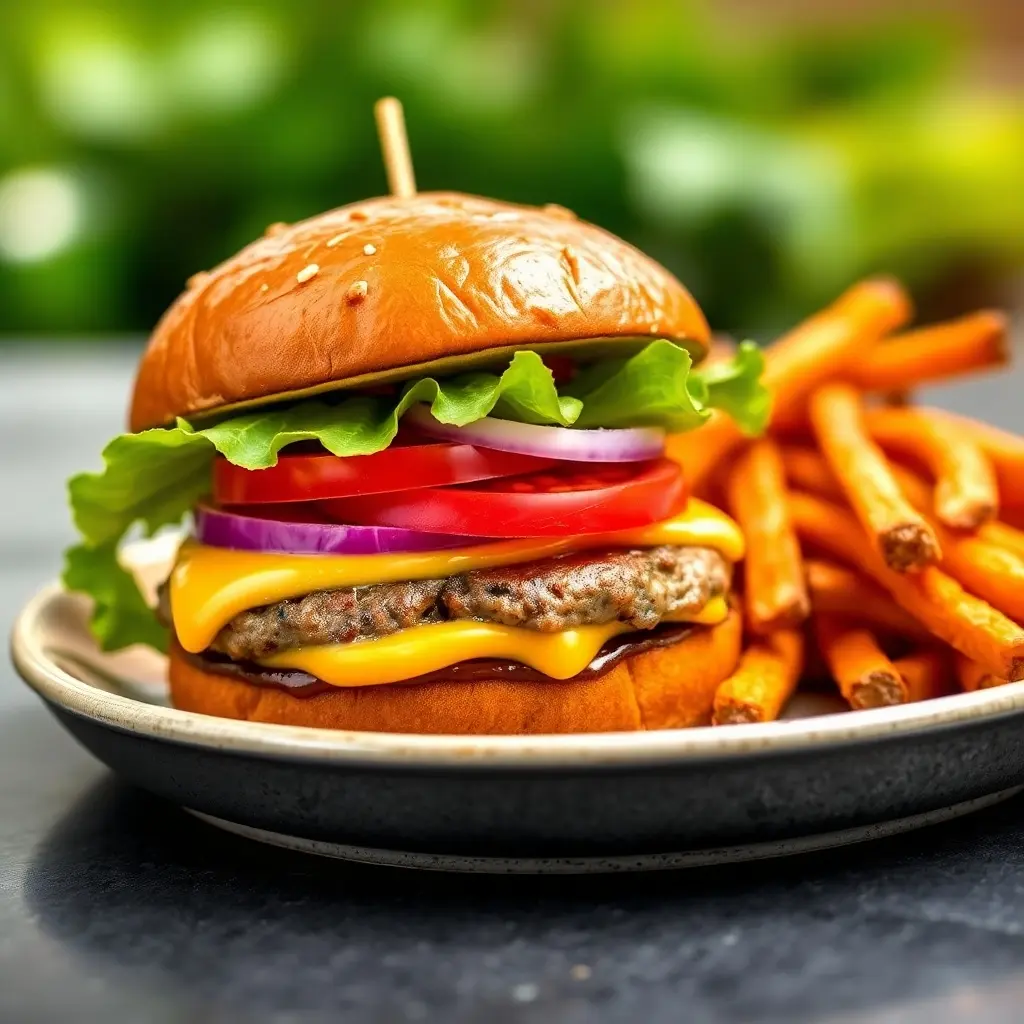Discover the incredible flavor of a bison burger recipe that’s not just healthy but irresistibly delicious. This gourmet guide dives deep into everything you need to know, from selecting the finest bison meat to crafting the perfect burger. Whether you’re looking to switch up your routine or impress guests at your next cookout, this guide ensures your bison burgers are juicy, flavorful, and unforgettable.
Part 1: Introduction to Bison Burgers
What is a Bison Burger?
Bison burgers are a leaner, healthier twist on the classic beef burger. Made with ground bison meat, these burgers boast a rich, slightly sweet flavor that sets them apart. Bison, often called buffalo in North America, has been a staple in indigenous diets for centuries. Today, it’s celebrated for its nutritional value and culinary versatility.
Unlike traditional beef, ground bison contains less fat, making it a better choice for health-conscious eaters. Don’t let the leanness fool you; bison burgers are juicy, tender, and packed with flavor when prepared correctly.
Health Benefits of Bison Meat
Why choose bison over beef? The answer lies in its nutritional profile. Bison meat is naturally lean, containing less cholesterol and saturated fat than beef. It’s also loaded with essential nutrients like iron, zinc, and vitamin B12, making it a powerhouse protein for energy and overall well-being.
Furthermore, bison meat is often grass-fed, meaning it’s higher in omega-3 fatty acids. These healthy fats support heart and brain health, so you’re not just eating deliciously—you’re eating smart.
Why Choose Bison Over Beef?
Besides being nutrient-dense, bison production is typically more environmentally friendly than beef. Bison are grazers, requiring fewer resources and leaving a smaller carbon footprint. They roam freely, contributing to sustainable agriculture practices.
Flavor-wise, bison offers a bold yet mild taste. It’s less gamey than venison but richer than beef, making it ideal for those who crave something different yet familiar.
Part 2: Selecting Quality Bison Meat
Where to Purchase Bison Meat
When it comes to making a bison burger recipe that stands out, starting with high-quality meat is essential. But, where exactly can you find this gourmet ingredient? You’ve got several options, depending on your location and preferences.
For those who enjoy the convenience of shopping locally, butcher shops and specialty meat markets often carry ground bison meat. Many of these establishments work directly with farms, ensuring the meat is fresh and responsibly sourced.
Additionally, you might find ground bison at your nearest natural food store or even in the organic section of large grocery chains. Always double-check the packaging to ensure it’s 100% bison without unnecessary fillers or additives.
Understanding Cuts Suitable for Burgers
Not all cuts of bison are created equal, particularly for burgers. Ground bison is the best choice for patties due to its blend of lean meat and fat. Because bison meat is leaner than beef, the fat content in ground bison typically ranges between 5% and 10%, offering a balance of flavor and juiciness.
If you prefer to grind the meat yourself, cuts like the chuck or round work wonderfully. These cuts are tender enough for burgers yet sturdy enough to hold their shape when cooked. Plus, grinding your own meat allows you to control the texture and freshness.
Tips for Storing and Handling Bison Meat
Proper handling is crucial, not only for food safety but also to maintain the quality of your bison meat. Store it in the refrigerator at 32°F to 40°F and use it within 1-2 days of purchase. For longer storage, freezing is your best bet. Wrap the meat tightly in freezer paper or vacuum-sealed bags to prevent freezer burn.
When thawing, always do so in the fridge rather than on the counter. This slower process ensures the meat stays fresh and safe to cook. Moreover, never forget to wash your hands, utensils, and surfaces thoroughly to prevent cross-contamination.
Part 3: Essential Ingredients for a Bison Burger

Core Components
Every great bison burger recipe begins with a handful of essential ingredients. At the heart of it all is the ground bison meat, which brings a lean, rich flavor that’s perfect for gourmet cooking. While the meat is undeniably the star, additional elements help bind the patties and enhance the flavor profile.
Start with a pound of ground bison. To ensure your patties hold together, incorporate a binder such as breadcrumbs or a lightly beaten egg. This step is especially important because bison, being leaner than beef, can sometimes struggle to stay intact without a little help.
Recommended Seasonings and Add-ins
Seasoning your bison burger is where creativity meets science. A simple blend of salt and freshly cracked black pepper might suffice, but adding garlic powder, onion powder, or smoked paprika can take your patties to the next level. For those who crave a hint of heat, a dash of cayenne or chili flakes can do wonders.
If you’re feeling adventurous, mix in Worcestershire sauce, Dijon mustard, or chopped fresh herbs like parsley or thyme. These add-ins not only enhance the flavor but also keep the meat moist. However, be careful not to overdo it; too many ingredients can overpower the natural taste of the bison.
Choosing the Right Bun and Toppings
Your choice of bun can make or break your bison burger recipe. Look for a soft, sturdy bun like brioche or pretzel that complements the patty without overwhelming it. Additionally, whole-grain or gluten-free buns are excellent options for those with dietary restrictions.
As for toppings, the possibilities are endless. Traditional choices like lettuce, tomato, and onions always work well, but you can elevate your burger with caramelized onions, avocado slices, or even a fried egg. For a final touch, consider adding a flavorful cheese like sharp cheddar, blue cheese, or Swiss.
Finally, don’t forget the condiments! A smear of garlic aioli, a dollop of spicy ketchup, or a drizzle of smoky barbecue sauce can tie everything together. Pairing the right toppings with the perfect bun ensures every bite is as satisfying as the last.
Part 4: Step-by-Step Cooking Instructions
Preparing the Patties
Crafting the perfect bison burger recipe starts with shaping the patties. Begin by placing the ground bison meat into a large bowl. Add your binder, such as a lightly beaten egg or breadcrumbs, and seasonings like salt, pepper, garlic powder, or smoked paprika. Mix gently but thoroughly to avoid overworking the meat, as this can lead to tough burgers.
Divide the mixture into equal portions, typically around 4-6 ounces each, depending on your desired patty size. Roll each portion into a ball, then flatten it gently into a patty that’s about three-quarters of an inch thick. For even cooking, press a small dimple into the center of each patty with your thumb. This technique helps the patties maintain their shape while cooking.
Cooking Methods
When it’s time to cook, the choice of method can make all the difference in texture and flavor. Whether you’re using a grill, stovetop, or air fryer, each technique offers its own unique advantages.
- Grilling: Preheat your grill to medium-high heat. Once hot, place the patties on the grates and cook for about 4-5 minutes per side, flipping only once. A meat thermometer ensures accuracy; aim for an internal temperature of 135°F for medium-rare or 145°F for medium.
- Pan-Searing: Heat a cast-iron skillet over medium-high heat and add a splash of oil. Cook the patties for 4-5 minutes on each side, letting them develop a rich, caramelized crust.
- Air Frying: For a quicker and cleaner option, preheat your air fryer to 375°F. Cook the patties for about 8-10 minutes, flipping halfway through. Check for doneness with a thermometer to prevent overcooking.
Ensuring Optimal Doneness
Achieving the right doneness is key to a juicy bison burger. Since bison meat is lean, it cooks faster than beef. Overcooking can result in dry patties, so keeping a close eye on the temperature is essential.
After removing the patties from the heat, let them rest for 3-5 minutes. This step allows the juices to redistribute, ensuring every bite is moist and flavorful. While it might be tempting to dig in immediately, patience pays off in the form of a perfectly cooked burger.
Part 5: Serving Suggestions and Pairings
Ideal Side Dishes
A great bison burger recipe deserves equally delicious sides. Fortunately, there are plenty of options to choose from, depending on whether you want something classic or a little more creative.
For a traditional pairing, crispy golden fries are a no-brainer. If you’re aiming for a healthier twist, sweet potato fries, roasted vegetables, or a vibrant side salad make excellent choices. A coleslaw, whether creamy or vinaigrette-based, offers a refreshing crunch that complements the rich flavor of the burger.
Additionally, if you’re feeling adventurous, grilled corn on the cob or a tangy cucumber salad can provide unique flavors. Whatever you choose, aim to balance the richness of the burger with lighter, flavorful sides.
Beverage Pairings
Although beverages can elevate the dining experience, it’s best to focus on non-alcoholic options for versatility. Sparkling water with a twist of lime, iced tea, or a fruity lemonade can cleanse your palate and keep the meal light.
If you’re hosting a gathering, you could also offer flavorful mocktails, such as a berry spritzer or a ginger-infused iced tea. These drinks pair beautifully with the robust flavors of a bison burger while keeping the experience refreshing and fun.
Presentation Tips
Presentation matters almost as much as taste, especially if you want to impress guests. To start, stack the burger with precision: bun, leafy greens, patty, cheese, and toppings like tomatoes or onions. For a gourmet touch, add a drizzle of aioli or sauce before topping with the final bun layer.
Serve the burger on a wooden board or a colorful plate to make it visually appealing. Adding a sprig of fresh herbs or a small portion of dipping sauce on the side creates a polished, restaurant-quality look.
Plating the sides creatively is just as important. Arrange fries or salad neatly, using ramekins for sauces or dips. These small touches transform an ordinary meal into an extraordinary experience.
Part 6: Nutritional Information and Considerations
 Calorie and Macronutrient Breakdown
Calorie and Macronutrient Breakdown
A bison burger recipe isn’t just delicious; it’s also packed with nutritional benefits. On average, a 4-ounce cooked bison patty contains around 150 calories, 22 grams of protein, and only 7 grams of fat. Compared to a similar serving of beef, bison offers a leaner profile while delivering comparable protein levels, making it an excellent choice for those monitoring their calorie intake.
Additionally, bison is rich in iron, which supports healthy blood and energy levels. The high-quality protein in bison aids muscle growth and repair, making it perfect for active individuals or anyone seeking a nutrient-dense meal.
Dietary Considerations
For individuals with specific dietary goals, bison burgers can be easily adapted. Because bison is naturally lean, it fits seamlessly into low-fat or high-protein diets. Pairing the patty with gluten-free buns or lettuce wraps ensures those avoiding gluten can enjoy a satisfying meal.
Moreover, if you’re following a low-carb or keto lifestyle, simply replace traditional buns with alternatives like portobello mushrooms or collard greens. These swaps reduce carbohydrate intake while maintaining a flavorful experience.
Allergen Information
Though bison meat itself is allergen-free for most, it’s important to pay attention to the ingredients used in your bison burger recipe. Breadcrumbs, certain sauces, or cheese toppings may contain allergens like gluten, dairy, or soy.
To avoid potential issues, consider using almond flour or gluten-free breadcrumbs as binders. Additionally, dairy-free cheese and homemade condiments can eliminate common allergens while still adding flavor. Always double-check ingredient labels, especially when cooking for guests with dietary restrictions.
Why Choose Bison for Better Nutrition?
Bison meat stands out not only for its taste but also for its health benefits. It’s naturally lower in cholesterol and saturated fat, making it heart-healthy. Additionally, the lack of artificial hormones or antibiotics in most bison farming practices ensures that you’re consuming a cleaner, more wholesome protein source.
Part 7: Frequently Asked Questions (FAQs)
How does bison meat taste compared to beef?
Bison meat has a slightly sweeter and richer flavor compared to beef, yet it isn’t overwhelming or gamey. Its mild taste makes it an excellent choice for those who enjoy beef but want something leaner and a bit more unique. Plus, its tender texture adds to the overall enjoyment.
Can I cook bison burgers to medium or well-done?
Yes, but bison meat is leaner than beef, which means it can dry out more quickly if overcooked. To maintain its juiciness, cooking to medium-rare (135°F) or medium (145°F) is ideal. Use a meat thermometer to ensure accurate cooking without compromising the texture.
What toppings go well with bison burgers?
The possibilities are endless! Classic toppings like lettuce, tomato, and onion work wonderfully, but don’t hesitate to experiment. Avocado slices, caramelized onions, or a dollop of garlic aioli can elevate the burger’s flavor. Pair these with a soft, sturdy bun to complete the experience.
Are bison burgers healthier than beef burgers?
Absolutely! Bison burgers are leaner, with fewer calories and less fat than traditional beef burgers. They’re also high in protein and packed with essential nutrients like iron and vitamin B12, making them a healthier choice without sacrificing taste.
How should I store leftover cooked bison burgers?
After cooling, wrap your leftover burgers tightly in aluminum foil or place them in an airtight container. Refrigerate them for up to three days. To reheat, use a low-temperature setting in the oven or microwave to retain moisture without overcooking.

